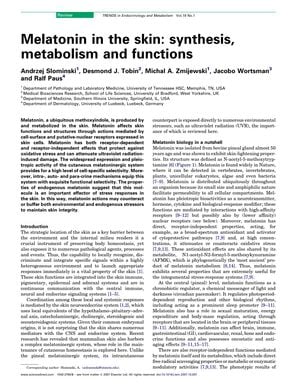Melatonin in the Skin: Synthesis, Metabolism, and Functions
January 2008
in “
Trends in Endocrinology and Metabolism
”

TLDR Melatonin in the skin helps protect against damage from stress and UV rays, and could be used to treat certain skin conditions.
The 2008 document reviews the synthesis, metabolism, and functions of melatonin in the skin, indicating that melatonin is produced in the skin and plays a crucial role in protecting against oxidative stress and UV radiation damage. It acts through receptor-dependent and independent mechanisms, with the skin expressing melatonin receptors MT1 and MT2, which can be influenced by environmental factors like UVB radiation. Melatonin and its metabolites have antioxidant properties, can inhibit lipid peroxidation, and stimulate antioxidative enzymes. The review also suggests that melatonin may influence skin functions such as hair growth and pigmentation and could have therapeutic applications for skin conditions like androgenic alopecia, skin cancer, and UV-induced skin damage. The document calls for further research to explore the therapeutic potential of melatonin in dermatology.










